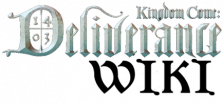[Clothing]
Clothing for villagers and other commoners above all had to be comfortable, durable and practical. It had to last for years and be worn in all kinds of weather. It generally consisted of simple shirts and tunics. Men also wore linen knickers down to their knees and in winter they wore hooded cloaks, fur jackets and caps. Wide-brimmed hats protected their heads from the sun and footwear was simple. Most items were of natural colours without ornamentation. An exception was festive apparel, intended for special celebrations and church holidays. In the towns, clothing held greater significance, reflecting status, wealth and even membership in certain factions, such as tradesmen, soldiers or apprentices.
Accessories included belts, bags, gloves, hats and other head coverings.
Most of the garments in Kingdom Come: Deliverance are based on actual historical records of Medieval fashion.
[Hairstyles]
In the 14th and 15th centuries, unwed young women had long hair, which they wore down or in braids. Women in towns adorned their hair with ribbons, pearls, wreaths and vines.
Older married women wore pearled nets on their heads, white or coloured veils or hats.
Fashionable men in the 15th century had long, coiffured hair and they liked to shave their chins. They covered their heads with brimmed hats, caps or hoods.
[Jewellery]
In the Middle Ages, jewellery was fashioned from gems, wood, leather and metals. All gold tended to be worn around the neck and breast rather than on the hand. The most common type of jewellery consisted of earrings and various types of crosses.
The most common motifs adorning jewellery were flowers and animals; figural decoration was often associated with religious themes.
[Rings]
were very popular in the High Middle Ages and were worn for both prestige and symbolic meaning.
They were either made entirely of metal (mostly bronze, in rare cases silver plate or copper wire) or adorned with precious stones and worn on all fingers.
[Footwear]
was made of leather (cow, calf, goat), as well as grass, straw, bast fibres, wood, cloth or felt. In the countryside people often went barefoot in the summertime.
Shoes were originally made from a single piece of material and fitted with straps. Soles (left and right) on shoes first appeared in the mid 14th century while heels were added in the 15th century.
The most common type of footwear consisted of sandals that covered the entire sole of the foot and slippers made of wood or cork. Stitched shoes could be either low or above the ankle.
VidyaWiki
